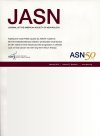Long Non-coding RNA NEAT1, NOD-Like Receptor Family Protein 3 Inflammasome, and Acute Kidney Injury
Long non-coding RNA (lncRNA) nuclear-enriched abundant transcript 1 (NEAT1) was upregulated in human and murine AKI. It returned to baseline after recovery in humans. Its knockdown preserved kidney function in animals.In vitro, LPS upregulated NEAT1 by TLR4/NF-κB signaling and caused its translocation into the cytoplasm where it activated nucleotide oligomerization domain-like receptor family protein 3 by binding receptor of activated protein C kinase 1.
Background
AKI is common in hospitalized patients and is associated with high mortality. Inflammation plays a key role in the pathophysiology of AKI. Long non-coding RNAs (lncRNAs) are increasingly recognized as regulators of the inflammatory and immune response, but its role in AKI remains unclear.
Methods
We explored the role of lncRNA nuclear-enriched abundant transcript 1 (NEAT1) in (1) a cross-sectional and longitudinal cohort of AKI in humans, (2) three murine models of septic and aseptic AKI, and (3) cultured C1.1 mouse kidney tubular cells.
Results
In humans, hospitalized patients with AKI (N=66) demonstrated significantly higher lncRNA NEAT1 levels in urinary sediment cells and buffy coat versus control participants (N=152) from a primary care clinic; among six kidney transplant recipients, NEAT1 levels were the highest immediately after transplant surgery, followed by a prompt decline to normal levels in parallel with recovery of kidney function. In mice with AKI induced by sepsis (by LPS injection or cecal ligation and puncture) and renal ischemia-reperfusion, kidney tubular Neat1 was increased versus sham-operated mice. Knockdown of Neat1 in the kidney using short hairpin RNA preserved kidney function and suppressed overexpression of the AKI biomarker neutrophil gelatinase-associated lipocalin, leukocyte infiltration, and both intrarenal and systemic inflammatory cytokines IL-6, CCL-2, and IL-1β. In LPS-treated C1.1 cells, Neat1 was overexpressed by TLR4/NF-κB signaling and translocated from the cell nucleus into the cytoplasm where it promoted activation of nucleotide oligomerization domain-like receptor family protein 3 inflammasomes by binding with the scaffold protein receptor of activated protein C kinase 1. Silencing Neat1 ameliorated LPS-induced cell inflammation, whereas its overexpression upregulated IL-6 and CCL-2 expression even without LPS stimulation.
Conclusions
Our findings demonstrate a pathogenic role of NEAT1 induction in human and mice during AKI with alleviation of kidney injury in three experimental models of septic and aseptic AKI after knockdown of Neat1. LPS/TLR4-induced Neat1 overexpression in tubular epithelial cells increased the inflammatory response by binding with the scaffold protein, receptor of activated protein C kinase 1, to activate nucleotide oligomerization domain-like receptor family protein 3 inflammasomes.




